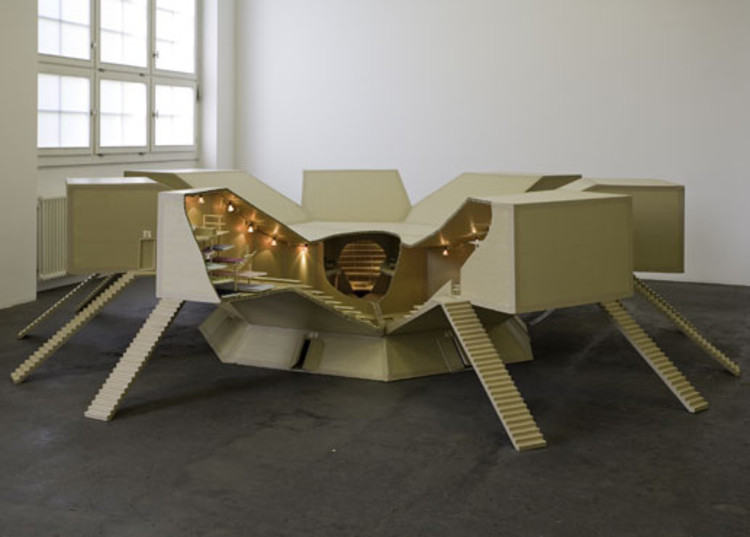
As if it was a mix in between Huxley | Orwell story, Atelier Van Lieshout from Rotterdam is developing this project since 2005. Just like in Brave New World, future society is an embodiment of the ideals that goes beyond ethics and liberty, and the artwork it’s obviously influenced in the scripts of fiction books from the early XX century, like mentioned Huxley’s Brave New World, Orwell’s Men Like God or maybe some D. H. Lawrence novels.
Let’s hear what they have to tell us after the break
SlaveCity can be described as a sinister distopian project, which is very rational, efficient and profitable (7 billion euro net profit per year). Values, ethics, aesthetics, moral, food, energy, economics, organization, management and market are turned upside-down, mixed and reformulated and designed into a town of 200.000 inhabitants. The ‘inhabitants’ work for seven hours each day in office jobs and seven hours in the fields of inside the workshop, before being allowed three hours of relaxation before they sleep for seven hours. SlaveCity is the first ‘zero energy’ town; it is a green town where everything is recycled and a city that does not squander the world’s resources.

TOTAL ENERGY USAGE PER YEAR: 88.013.630 kWh/a Electricity: 66.774.256 kWh/a Thermal energy: 21.236.374 kWh/a
Excrements Excrements Fresh Substance per person and day: 0,40 kg FS per year: 29.000 ton Dry Substance (FS): 23 % Organic Substance (DS): 85 % Gas/kg (08): 520 l Gas production per year: 2.968.472 m3
Agricultural waste Fresh Substance: 11.440 ton Dry Substance (FS): 48 % Organic Substance (DS): 83 % Gas/kg (OS): 520 l Gas production per year: 2.382.613 m3
Wind turbines: 2.750 kW Energy output per annum: 5,29 GWh/a Wind turbines: 10 pieces Electrical energy: 53.787.732 kWh/a
Thermo photovoltaic device: 350 kWh/a Needed M2: 23.214 m3
Rape seed: 4,11 t/ha Percentage diesel: 38 % Percentage rape pie: 60 % Bio diesel: 1,58 t/ha Rape pie: 2,50 t/ha Planned rape seed: 22 ha Total production bio diesel: 34.310 l
The Mall, situated in SlaveCity’s public area is a giant biomorphic baroque shopping centre. With 26 floors this humongous building is the worlds largest boundless consumer paradise, opened 24/7. The Mall houses countless shops that are irrationally chosen by Joep, consisting of numerous luxury good stores, with upstairs a recreational area including brothels, bars, night clubs, casinos, and a spa. Other floors house fashion stores, art galleries, design and furniture stores as well as convenience services. Downstairs you will find an arena for entertainment fights with supermarkets and quality organic food suppliers. Furthermore a health department with pharmacies and dental- and medical care as well as a hair- and beauty salon, a cosmetic surgery parlor.

The Mall: the shopping city, just to kill time.
Female Slave University, a model of the elegant and efficiently designed education center within SlaveCity, a contemporary labour camp. It consists of 12 auditoriums piled up and surrounded by slopes. There are two Slave Universities, one for males and one for females. On top of the Female Slave University is a meeting room for the professors, who are the only ones receiving payment for their work, in this building. The other rooms are for the female slaves who are being educated to function good and efficient within the objectives of SlaveCity. The Female Slave University goes on 24/7, the slaves are functioning in 7 hour shifts (7 hours of study, 7 hours of work on the grounds or other supportive activities, 7 hours of rest and 3 hours of personal care such as eating, washing and relaxing). The Female Slave University offers room for 1896 female students and has 632 places to work, 632 sleeping-accommodations and 124 toilet units linked to a environmental friendly biogas installation.

The ‘participants’ of SlaveCity are not being paid for their work in the call centers. Instead of a payment they receive privileges such as a visit to a brothel. The brothels for the higher-class slaves are far more luxurious. In this triangle shapes brothel the slaves can choose between different kinds of pleasure.


Atelier Van Lieshout (AVL), founded by artist Joep van Lieshout (1963) in 1995, is a multidisciplinary art practice encompassing installation, design, furniture and architecture. The name Atelier Van Lieshout emphasises the fact that the works of art do not stem solely from the creative brain of Joep van Lieshout, but are produced by a creative team of artists, designers and architects.
I want to thank Manolo Fernández to catch my attention over this project.












